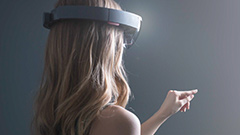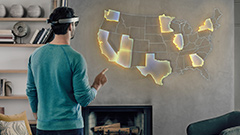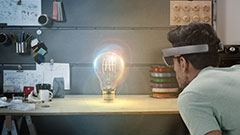Microsoft HoloLens is the first fully self-contained, holographic computer, enabling you to interact with high‑definition holograms in your world.
Microsoft HoloLens, the company’s holographic, augmented reality headset.
The market for virtual reality devices is expected to be 80 million devices per year by 2020. However, many of today’s devices and experiences do not work with each other, provide different user interfaces, interaction models, input methods, peripherals, and content. And most virtual reality experiences can’t mix real people, objects, and environments into the virtual world, making creation and collaboration difficult. This is because they lack the human, environmental and object understanding that is already built into Windows 10.



Transform the ways we communicate, create, collaborate, and explore. Your ideas are closer to becoming real when you can create and work with holograms in relation to the world around you.
The set-up consists of holographic lenses and a depth camera as well as speakers above the ears and on-board processing via an Intel 32-bit architecture, an unspecified GPU and HPU (holographic processing unit). That’s backed up by 2GB of RAM and 64GB of onboard storage. There’s also a vent to keep the headset from overheating. On the connectivity front, it’ll support both Bluetooth and Wi-Fi, as had been expected.
There’s a host of sensors built into the headset as well, which include an ambient light sensor and four environment sensing cameras that work in combination with a depth sensing camera to create the spaces that you’ll be able to work within.
That’s also accompanied by a 2-megapixel HD camera to take photos and record mixed reality video, with audio capture covered by an array of four microphones.
